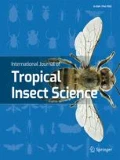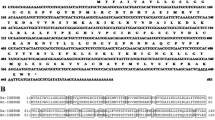Abstract
Adult female Rhipicephalus appendiculatus ticks were fed on rabbits immunized with either bovine serum albumin, solubilized tick midgut membrane proteins, a 50:50 mixture of bovine serum albumin and solubilized tick midgut membrane proteins or buffer. Haemolymph harvested from these ticks after they had fed to engorgement and sera from the immunized rabbits were assayed for the presence and quantity of both the total rabbit IgG and specific rabbit IgG raised against bovine serum albumin using the enzyme linked immunosorbent assay technique. The results obtained indicated that rabbit IgG was able to cross the midgut barrier of the tick into the haemolymph. Furthermore, the amounts of IgG crossing into the haemolymph were dependent on the antibody titres in the serum. The results also showed that feeding ticks on blood containing anti-tick midgut antibodies increased the passage of IgG into the haemolymph.
Résumé
Des tiques Rhipicephalus appendiculatus femelles ont été nourries sur des lapins immunisés à partir soit d’albumine sérique bovin, soit de proteines solubles issues de la membrane intestinale de tiques, soi d’un mélange à égale des deux précédentes substances ou à partir d’une solution tampon. Il a été procédé a moyen de la technique de l’ELISA au dosage de l’IgG des lapins dans l’hémolymphe des tiques de même qu’à l’estimation de la quantité d’hémoglobine secrétée par les lapins contre les substances à eux injectées. Les résultats obtenus, indiquent que l’IgG des lapins peut traverser la barrière intestinale de la tique et se retrouver dans l’hémolymphe. Ils indiquent aussi que le taux d’IgG traversant la barrière intestinale de la tique dépend du taux d’anticorps sérique. Ces résultats de la même manière indiquent que la prise de nourriture par des tiques sur des animaux immuns contre des proteines de tiques d’origine intestinale endommage les structures intestinales et augmente le passage des anticorps de l’intestine à l’hémolymphe.
Similar content being viewed by others
References
Ackerman S., Brian Clare F., McGill T. W. and Sonenshine D. E. (1981) Passage of host serum components, including antibody, across the digestive tract of Dermacentor variabilis (Say). J. Parasitol. 67, 737–740.
Agbede R. I. S. and Kemp D. H. (1986) Immunization of cattle against Boophilus microplus using extracts derived from adult female ticks: Histopathology of ticks feeding on vaccinated cattle. Int. J. Parasitol. 16, 35–41.
Akov S. (1982) Blood digestion in ticks. In Physiology of Ticks (Edited by Obenchain F. D. and Galun R.), pp. 197–211. Pergamon Press, Oxford.
Bailey K. P. (1960) Notes on the rearing of Rhipicephalus appendiculatus and their infection with Theileria parva for experimental transmission. Bull. Epizoot. Dis. Afr. 8, 33–43.
Balashov Y. S. (1972) Blood-sucking tick (Ixodidea) vectors of diseases of man and animals. Misc. Publ. entomol. soc. Am. 8, 161–376.
Ben-Yakir D., Fox C. J., Homer J. T. and Barker R. W. (1987) Quantification of host immunoglobulin G in the haemolymph of ticks. J. Parasitol. 73, 669–671.
Ben-Yakir D. (1989) Quantitative studies of host immunoglobulin G in the haemolymph of ticks. J. med. entomol. 26, 243–246.
Ben-Yakir D., Carl Fox J., Homer J. T. and Barker R. W. (1986) Quantitative studies of host immunoglobulin G passage into the hemocoel of the ticks Amblyomma americanum and Dermacentor variabilis. In Morphology, Physiology and Behavioural Biology of Ticks (Edited by Sauer J. R. and Hair J. A.), pp. 329–341. Ellis Horwood, Chichester.
Berdyer A. and Khudainazarova S. N. (1976) A study of acquired resistance to adults of Hyalomma asiaticum asiaticum in experiment on lambs. Parasitologiya 10, 619–625.
Bram R. A. (1975) Tick-borne livestock diseases and their vectors. I. The global problem. Wld. A. Rev. 16, 1–5.
Chinzei Y. and Minoura H. (1987) Host immunoglobulin G titre and antibody activity in haemolymph of the tick, Ornithodorosmoubata. Med. Vet. Entomol. 1, 409–416.
Dolan T. T. and Young A. S. (1981) An approach to the economic assessment of East Coast fever in Kenya. In Advances in the Control of Theileriosis (Edited by Irvin A. D., Cunningham M. P. and Young A. S.), pp. 412–415. The Hague, Nijhoff Publishers.
Fujisaki K., Kamio T. and Kitaoka S. (1984) Passage of host serum components including antibodies specific for Theileria sergenti, across the digestive tract of argasid and Ixodid ticks. Ann. trop. Med. Parasitol. 78, 449–450.
Galun R. (1978) Control of livestock pests by interference in their development. UC/AID Pest Management and Relative Environmental Protection Progress Report. Bogota, Colombia.
Irvin A. D. and Brocklesby D. W. (1970) Rearing and maintaining Rhipicephalus appendiculartus in the laboratory. J. Ins. Anim. Tech. 21, 106–112.
Kemp D. H., Agbede R. I. S., Johnson L. A. Y. and Gough J. M. (1986) Immunization of cattle against Boophilus microplus using extracts derived from adult female ticks: Feeding and survival of the parasite on vaccinated cattle. Int. J. Parasitol. 16, 115–120.
Minoura H., Chinzei Y. and Kitamura S. (1985) Ornithodoros moubata: host immunoglobulin G in tick haemolymph. Exp. Parasitol. 60, 355–363.
Ouchterlony O. (1958) Diffusion-in-gel methods for immunological analysis. In Progress in Allergy (Edited by Kallos P.), Vol. 5, pp. 1–78. Karger, Bassel.
Roberts J. A, (1968) Acquisition by the host of resistance to the cattle tick Boophilus microplus (Canestrini). J. Parasitol. 54, 657–662.
Steelman C. D. (1976) Effects of external and internal arthropod parasites on domestic livestock production. Annu. Rev. Entomol. 21, 155–178.
Tracey-Patte P. D., Kemp D. H. and Johnston L. A. Y. (1987) Boophilus microplus: passage of bovine immunoglobulins and albumin across the gut of cattle ticks feeding on normal or vaccinated cattle. Res. Vet. Sci. 43, 287–290.
Voller A., Bidwell D. E. and Bartlett A. (1979) The Enzyme Linked Immunosorbent Assay. Dynatech Laboratories, Alexandria, Virginia.
Wikel S. K. (1988) Immunological control of haematophagous arthropod vectors: utilization of novel antigens. Vet. Parasitol. 29, 235.
Author information
Authors and Affiliations
Rights and permissions
About this article
Cite this article
Mbogo, S.K., Osir, E.O. & Mongi, A.O. Host Immunoglobulin G in the Haemolymph of the Brown Ear Tick, Rhipicephalus Appendiculatus (Neumann, 1901). Int J Trop Insect Sci 13, 481–485 (1992). https://doi.org/10.1017/S1742758400016052
Received:
Revised:
Published:
Issue Date:
DOI: https://doi.org/10.1017/S1742758400016052
Key Words
- Enzyme linked immunosorbent assay
- immunization
- IgG in tickhaemolymph
- Rhipicephalus appendiculatus
- solubilized tick midgut membrane proteins




